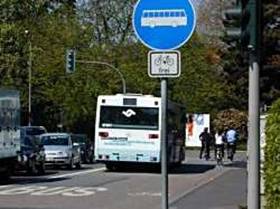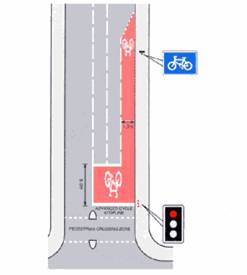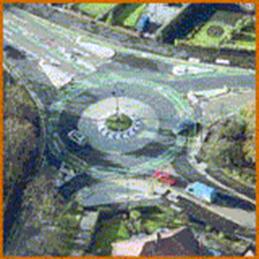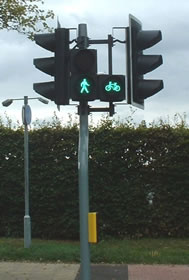
Taxonomy and description
Terminology and Technology
A wide range of measures designed to aid cycling can be implemented. These range from cycle tracks to cycle signage and cycle lockers. Every component plays a part in the creation of a comprehensive network of cycle facilities. Within this review the focus is on those priority facilities, which have the potential of affecting the level of road congestions.
Technical and legal definitions for such measures show some variations depending on the definition’s source. Here the following definitions have been adopted.
 Cycle track – a way for pedal cycles, which can either be part of a highway adjacent to a carriageway or a separate highway in its own right. A cycle track is a way over which the public have right of way on pedal cycles with or without the right of way on foot. It may physically comprise all of a footway (unsegregated ), or be one part of a footway (segregated), or not be part of a footway at all. Note that pedestrians may still have right of way even across cycle tracks that are segregated. Highway agencies have to power to construct a cycle track as part of a highway maintainable at public expense, which include a made-up carriageway, and to light the cycle track. Highway agencies also can to alter or remove a cycle track. Cycle Track Cycle track – a way for pedal cycles, which can either be part of a highway adjacent to a carriageway or a separate highway in its own right. A cycle track is a way over which the public have right of way on pedal cycles with or without the right of way on foot. It may physically comprise all of a footway (unsegregated ), or be one part of a footway (segregated), or not be part of a footway at all. Note that pedestrians may still have right of way even across cycle tracks that are segregated. Highway agencies have to power to construct a cycle track as part of a highway maintainable at public expense, which include a made-up carriageway, and to light the cycle track. Highway agencies also can to alter or remove a cycle track. Cycle Track
Cycle Lane – a part of a carriageway allocated for use by cyclists. Advisory cycle lanes are indicated by a broken white line that allows motor vehicles to cross if necessary and park if not so restricted. A mandatory cycle lane on a carriageway is indicated by a solid white line and motor vehicles may not cross into the cycle lane.
Cycle lanes help to maintain a more consistent distance between cyclists and motor vehicles than could occur without a lane or with a wide nearside lane. They give cyclists a well defined space and a sense of route continuity. In congested areas cycle lanes can help to keep routes free from traffic and allow cyclists to overtake on the left. They are relatively cheap and easy to introduce and can be provided in physically constrained environments without sufficient space for a segregated facility. In comparison to cycle tracks cycle lanes link more easily with junctions. It is often argued that they improve cyclists’ safety as cyclists are more visible to drivers but opinions on this are divided.

Advisory Cycle Lane Mandatory Cycle Lane
Design guidelines recommend a minimum width for cycles lanes of between 1.5 and 2 meters but meeting the full recommended with on narrow or congested roads can be difficult. Where the function of a cycle lane is to channel traffic, for example on the approach to junctions or where queuing traffic blocks the cyclists’ route, widths down to 1.2metres may be useful but on short stretches only (CTC 1996).

Where mandatory cycle lanes are provided sufficient carriageway must remain for motor vehicles to pass each other, although this may be as little as 2.5m per lane. Where a mandatory cycle lane is unsuitable, for example, where occasional encroachment by motor vehicles is essential, an advisory cycle lane may be useful (CTC 1996).
 Shared Bus Lanes – a part of a carriageway allocated for the use by buses which now are generally available for use by cyclists although extra width is desirable. In town centres and on urban main roads bus/cycle lanes can improve safety and convenience for cyclists. They give access to areas closed to general traffic and physically distance cyclists from cars and lorries. Bus/cycle lanes are often introduced where it is easier to justify a lane for both cyclists and buses than for cyclists or buses only. Shared Bus Lanes – a part of a carriageway allocated for the use by buses which now are generally available for use by cyclists although extra width is desirable. In town centres and on urban main roads bus/cycle lanes can improve safety and convenience for cyclists. They give access to areas closed to general traffic and physically distance cyclists from cars and lorries. Bus/cycle lanes are often introduced where it is easier to justify a lane for both cyclists and buses than for cyclists or buses only.
Combined Bus and Cycle Lane
 Advanced Stop Lines - provide a waiting area for cyclists between two stop lines, one for motorists and one advanced stop line (ASL) for cyclists. A cycle lane, usually on the left, allows cyclists to bypass the traffic queue and reach the waiting area. This positions cyclists in well visible locations in front of motor vehicles and allows them to turn or go ahead safely when the lights change to green. Advanced Stop Lines - provide a waiting area for cyclists between two stop lines, one for motorists and one advanced stop line (ASL) for cyclists. A cycle lane, usually on the left, allows cyclists to bypass the traffic queue and reach the waiting area. This positions cyclists in well visible locations in front of motor vehicles and allows them to turn or go ahead safely when the lights change to green.
In some situations it may be more appropriate to stagger the stop lines. This arrangement also places the cyclists ahead of motor vehicles so they are more easily seen by drivers.
Schematic Layout of Advanced Cycle Lane
 Roundabouts – Roundabouts, particularly large ones and those with minimal deflections, often pose a safety risk to cyclists. The most common type of accident involving cycle traffic is where an entering motor vehicle collides with a circulating cyclist. Roundabouts – Roundabouts, particularly large ones and those with minimal deflections, often pose a safety risk to cyclists. The most common type of accident involving cycle traffic is where an entering motor vehicle collides with a circulating cyclist.
This risk can be reduced by reducing motor vehicles’ speed through the introduction of signaling the roundabout, providing a segregated cycle track or redesigning the roundabout for appropriate user groups. Features to be considered are reduced entry and circulatory widths, and increased angle of entry (deflection). Small roundabouts and mini roundabouts can be beneficial to cyclists’ safety if decreasing vehicle speeds at a junction.
Roundabout with Cycle Lanes in York
At many large roundabouts signals have been introduced, usually in order to increase capacity at peak times and to ease movement from some approach arms where continuous traffic from other arms makes it difficult to enter the roundabout. Signals have the added benefit of reducing safety risks to cyclists as vehicles should no longer enter when traffic is circulating in front of them. Such measures have shown to reduce accident rates for cyclists by more than 60% (Lines 1995, sighted in CTC 1996).
 Toucan Crossing - provided for cyclists and pedestrians and is associated with a cycle lane or track. It is usually 4 metres wide, rather than the standard 2.8 metres for a Pelican or Puffin crossing. A green cycle indicator is provided alongside the green man, which can be mounted either on the far side of the crossing like a Pelican, or on the nearside like a Puffin. Toucan Crossing - provided for cyclists and pedestrians and is associated with a cycle lane or track. It is usually 4 metres wide, rather than the standard 2.8 metres for a Pelican or Puffin crossing. A green cycle indicator is provided alongside the green man, which can be mounted either on the far side of the crossing like a Pelican, or on the nearside like a Puffin.
Toucan crossings often have detectors which will extend the time available for pedestrians and cyclists to cross the road and a further set of detectors will cancel the demand for the crossing if the pedestrian or cyclist moves away from the crossing area. Zigzag markings are laid on both the approaches and the exits to the crossing. The zigzags ban waiting or parking, prohibit vehicles from overtaking each other.

|

